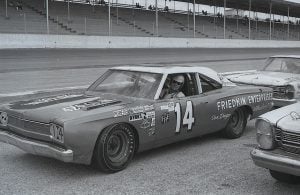Bobby Isaac recorded his 11th and final victory of the 1970 NASCAR Cup Series season on Sunday afternoon, Oct. 4, at North Wilkesboro (N.C.) Speedway, driving the No. 71 Dodge owned by Nord Krauskopf and prepared by legendary mechanic Harry Hyde.
The native of Catawba, N.C., took the checkered flag, made his way to victory lane and then went to the press box for interviews. While Isaac was explaining his winning strategy, the mood in the press box suddenly became more serious.
All indications were that veteran NASCAR driver Curtis Turner had perished an hour or so earlier in a private airplane crash, along with professional golfer Clarence King.
Turner’s Aero Commander 500 had gone down near Punxsutawney, Pa., just after takeoff from the DuBois Regional Airport en route to Woodrum Field at Roanoke–Blacksburg Regional Airport in Virginia.

Isaac, the eventual 1970 Cup Series champion, offered his condolences prior to heading home.
Turner’s plane had only been in the air 20 minutes when it experienced issues. Eyewitness accounts claimed one engine failed before the plane spiraled into the ground. In addition, the National Transportation Safety Board review said Turner was “impaired by alcohol.” It also said King suffered an apparent heart attack during the flight.
Still, 53 years later, exactly what happened on that ill-fated flight remains a mystery.
Those who raced against Turner or wrote articles about him during his driving career endured a longer and darker drive home that night from North Wilkesboro.
Humpy Wheeler, president and general manager of Charlotte Motor Speedway from 1975 to 2008, remembers Turner as a risk-taker.
“The NASCAR community was sad to hear the news that we had lost Curtis, but I don’t believe anyone was shocked,” Wheeler said. “Everyone had heard about all the airplane antics associated with Curtis. The Cup Series, then called the Grand National division, was having a typical late fall afternoon race. But when the crash happened, everyone went into reporter mode. Someone from one of the newspaper offices, possibly the Charlotte Observer, called their motorsports writer, Tom Higgins, when they saw it come across the wire, and let him know.”
Turner was only 46 years old when he died. The native of Floyd, Va., carried a reputation for creating breathtaking stories, the next one more harrowing than the last. Airplanes and fast cars, both on and off the track, were his vehicles of choice for taking him from one unbelievable adventure to the next.
“I do know for a fact one thing he did,” radio announcer Barney Hall, an experienced pilot himself, wrote in his book, “Tales from Trackside.” “He had an alarm clock that he used to set when he was close to landing. … I’ve talked to a lot of people who have flown with Turner who saw him do it. A lot of people who have no flying experience whatsoever, and most of them never flew with him again. He’d tell them to wake him up in 20 minutes or whatever. I thought he was kidding, but he’d go crawl in the back seat and leave them up there (in the cockpit) shaking in their shoes. It was a pretty frightening experience but that was just the way Curtis was.”
Turner’s unorthodox flying exploits are known far and wide among NASCAR historians and include the infamous story from 1967 when he dropped in on a friend in Easley, S.C., to get some liquor as church was letting out one Sunday afternoon.
As he took off, the tail of the plane caught some power and phone lines, prompting a visit from Federal Aviation Administration officials when he landed in Charlotte. Turner lost his pilot’s license for many months.
Growing up to the smell of oak, walnut and poplar on tracts of Virginia land around his father Morton Turner’s sawmill between Floyd and Stuart, Turner dreamed of a life beyond the tree lines of the Blue Ridge Mountains.
He made his first money of 10 cents per hour at age 14, providing water to the workers that ran the large steel blades on outdoor table saws.
At age 18, Turner knew everything there was to know about the lumber business. By the time he reached his 30s in the early 1950s, he could fly over tracts of timber and accurately estimate the number of board feet and the money the trees would bring. But the woodlands weren’t enough, and there was always a better way to make money outside the sawmill gates.
Turner was a walking, talking showman. After attending a race in Mt. Airy, N.C., that was canceled, he put his 1939 Ford on the frontstretch, grabbed two bottles of moonshine from the trunk of his car and showed 50 or so remaining fans how to squeeze between them at a high rate of speed – in reverse – time after time.
